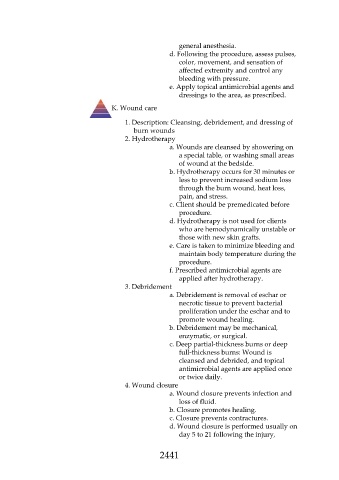Page 2441 - Saunders Comprehensive Review For NCLEX-RN
P. 2441
general anesthesia.
d. Following the procedure, assess pulses,
color, movement, and sensation of
affected extremity and control any
bleeding with pressure.
e. Apply topical antimicrobial agents and
dressings to the area, as prescribed.
K. Wound care
1. Description: Cleansing, debridement, and dressing of
burn wounds
2. Hydrotherapy
a. Wounds are cleansed by showering on
a special table, or washing small areas
of wound at the bedside.
b. Hydrotherapy occurs for 30 minutes or
less to prevent increased sodium loss
through the burn wound, heat loss,
pain, and stress.
c. Client should be premedicated before
procedure.
d. Hydrotherapy is not used for clients
who are hemodynamically unstable or
those with new skin grafts.
e. Care is taken to minimize bleeding and
maintain body temperature during the
procedure.
f. Prescribed antimicrobial agents are
applied after hydrotherapy.
3. Debridement
a. Debridement is removal of eschar or
necrotic tissue to prevent bacterial
proliferation under the eschar and to
promote wound healing.
b. Debridement may be mechanical,
enzymatic, or surgical.
c. Deep partial-thickness burns or deep
full-thickness burns: Wound is
cleansed and debrided, and topical
antimicrobial agents are applied once
or twice daily.
4. Wound closure
a. Wound closure prevents infection and
loss of fluid.
b. Closure promotes healing.
c. Closure prevents contractures.
d. Wound closure is performed usually on
day 5 to 21 following the injury,
2441

